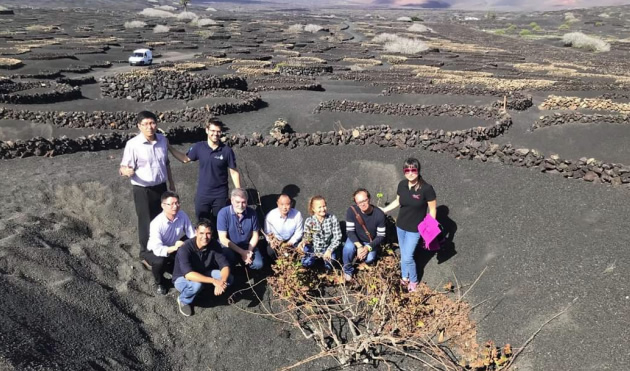The Green Moon Project has an ambitious plan to transform objects in space into sources of food. We caught up with José María Ortega-Hernández to find out more.
Could you give an overview of the Green Moon Project?
The Green Moon Project is about Space Agriculture. It is possible to see how important this will be in the near future since many crewed missions, thanks to the space accessibility democratization, will end on the Moon surface or even on Mars. In addition to that, space tourism seems to be a very powerful business as well.

The project is made up of three main building blocks: planetary geology, plant biology and space technology. We are using the Lanzarote Island (in the Canary Islands in Spain) as our main natural island since we are using the soil from the volcanic Timanfaya National Park as a simulant of the one that is expected to be found on the Moon or even Mars in order to perform our tests on Earth to simulate what is going to be happening in these celestial bodies.
In addition to that, we have a collaboration agreement signed with the Center of Space Exploration (COSE) in Chongqing that will allow us to join a potential future Chinese mission to the Moon to better understand how crops will behave under lunar gravity conditions which are six times lower than Earth gravity.
What was your own career path before forming the company which led you to this point?
I did study Aeronautical and Mechanical Engineering as a bachelor and then I completed it with a Master in Mechanical Manufacturing Engineering.
At the same time I am coordinating Green Moon Project, I am finishing the PhD in Space Agriculture Technology at both Wrexham Glyndwr University (Wales) and the University of Chester (England) both in the United Kingdom. In addition to that, I did manage to become Vehicle Architecture Engineer at the British car manufacturer, Bentley Motors Limited.
Back at University, when we started Green Moon Project in September 2016, we competed in a competition called Lab2Moon in India within the Google Lunar X Prize.
The project was originally selected as one of the 15 finalists among more than 3400 projects submitted all around the world.
What makes your particular solution special and different from previous kinds of technology or other companies?
At Green Moon Project we are merging the best from the three main building pillars of the project as Planetary Geology, Plant Biology and Space Engineering to offer something that has never been shown before.
For instance, the project not only wants to understand how crops will behave under the lunar gravity which is six times lower than Earth gravity but also, it wants to understand the interaction between the plant and the soil.
This is a really new and different approach never seen before.
Who are you currently working with?
We have many partnerships and collaborations. For instance from the Spanish public perspective we count on the support from the Instituto de Geociencias and from the Spanish private side, the Research and Development Agriculture company called InnoPlant. From an international perspective, we count on the support from the Chinese Center of Space Exploration. The same ones that managed to first plant on the Moon during the Chang’ e 4 mission to the Moon.
What stage of testing are you at now?
We have many partnerships and collaborations.
For instance from the Spanish public perspective we count on the support from the Instituto de Geociencias and from the Spanish private side, the Research and Development Agriculture company called InnoPlant. From an international perspective, we count on the support from the Chinese Center of Space Exploration.
The same ones that managed to first plant on the Moon during the Chang’ e 4 mission to the Moon.
What stage of testing are you at now?
We are mainly testing the horticultural crops on top of the basaltic soil /taken from the volcanic Lanzarote island) as a simulant of the soil that we may find on the Moon or Mars.

We are planning to perform more tests in Lanzarote and Granada in Spain. Potentially, we will be launching the first experiments to the Moon.
We are currently focus on the new encapsulated greenhouse to better understand how crops will grow under the lunar conditions. These encapsulated environments manage to have the same conditions that there exist on Earth but o the Moon.
The only variables are lunar gravity and cosmic radiation. Knowing those differences, it is want is wanted to better understand.
What is the next step?
Finish the next encapsulated greenhouse construction, continue with more tests and open new round of investors.
What is your dream outcome for the project?
To be not only launching those encapsulated environments to the Moon and Mars but even beyond. The main scientific target of the project is to better understand how crops will behave under different celestial bodies conditions.
As Elon Musk said, humankind will become an interplanetary species and that is why we really need to understand how crops will behave under different conditions sine they will not only feed the humans in these new environments but also will provide them with oxygen and will make a carbon dioxide removal.
In the future, the idea is to be using the data collected to better create those big greenhouses (potentially to be firstly located in lunar or martian lava tubes) since they will be protected from the cosmic radiation.
We will have those greenhouses on the Moon or even Mars but we have to know all that information previously to the human arrival to those places. The main target in 10 years time, will be to have the first greenhouses on the Moon with the data collected from our first small encapsulated environments in order to support future habitability using the space resources located in-situ (ISRU).
For more information visit greenmoonproject.com.
